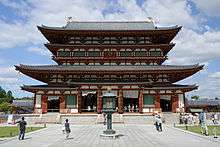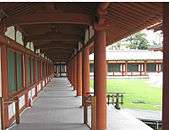Yakushi-ji
Yakushi-ji (薬師寺) is one of the most famous imperial and ancient Buddhist temples in Japan, that was once one of the Seven Great Temples of Nanto, located in Nara. The temple is the headquarters of the Hossō school of Japanese Buddhism. Yakushi-ji is one of the sites that are collectively inscribed as a UNESCO World Heritage Site, under the name of "Historic Monuments of Ancient Nara."[1]
| Yakushi-ji 薬師寺 | |
|---|---|
 | |
| Religion | |
| Affiliation | Hossō |
| Deity | Yakushi Nyorai (Bhaiṣajyaguru) |
| Location | |
| Location | 457 Nishinokyō-chō, Nara, Nara Prefecture |
| Country | Japan |
| Architecture | |
| Founder | Emperor Temmu |
| Completed | 680 |
| Website | |
| http://www.nara-yakushiji.com/ | |
The main object of veneration, Yakushi Nyorai, also named "The Medicine Buddha", was one of the first Buddhist Deities to arrive in Japan from China in 680, and gives the temple its name.
History
The Jinshin Wars in Japan in 672 resulted in moving the capital from Otsu, and back to Asuka. The movement of the capital was due to family disputes over money and power inevitably leading to civil war between Prince Naka and Prince Ōama. Prince Ōama desired power over Prince Naka’s son, who was favored by his father to take the throne after his rule. After disagreements between Prince Ōama and Prince Naka’s son, Prince Ōtomo resulted in Prince Ōama’s victory over his brother and nephew. Prince Ōama, as Tenmu, was responsible for moving the temple from Ostu back to Asuka in 672.[2] The original Yakushi-ji was built in Fujiwara-kyō, Japan's capital in the Asuka period. The Fujiwara capital was built during this time reflecting a Chinese-style capital[3] with hopes of improving economic stability and centralization of government as well as a strong military. Yakushi-ji was commissioned by Emperor Tenmu in 680 to pray for recovery from illness for his consort, who succeeded him as Empress Jitō. This act of building temples in devotion to Buddhist figures was a common practice among Japanese nobility when Buddhism was first imported from China and Korea. Emperor Tenmu had died by the time Empress Jitō completed the complex around 698; and it was disassembled and moved to Nara eight years after the Imperial Court settled in what was then the new capital.[4] The Nara Period (710–794) began with the transfer of the capital to Nara in 710 from the Fujiwara Capital. This was due to a similar reason for the movement of the capital to Fujiwara, which was the desire to build a strong, centralized government in the capital of Nara. Emperor Shōmu instigated the construction of the “Seven Great Temples”: Tōdai-ji, Kōfuku-ji, Gangō-ji, Daian-ji, Yakushi-ji, Saidai-ji, and Hōryū-ji[5]
It has been long believed that the temple was moved to its present location in 718, following the move of the capital to Heijō-kyō known today as Nara. However, excavations of the Fujiwara-kyō Yakushi-ji site in the 1990s suggest that there may have been two Yakushi-ji at one time. The Fujiwara-kyō Yakushi-ji is also referred to as Moto Yakushi-ji (元 moto, original).
Fires destroyed most buildings of the complex in 973, and the main hall in 1528. Much hard work has been put into restoration: the main hall was rebuilt in the 1970s, and the entire temple is now completely restored.
East Pagoda
The East Pagoda (東塔, Tō-tō), completed in 730 during the Nara period, is the only original 8th-century structure at Yakushi-ji.[1] The structure stands at 34 metres (112 ft), and is regarded as one of the finest pagodas in Japan, representing Hakuhō to Tenpyō period architecture. The East Pagoda has just three stories, but seems to have six because of the presence of inter-storey pent roofs (mokoshi). The structure is topped by a distinctive globe-shaped finial. The East Pagoda was disassembled for repair work from 1898–1900, and disassembled again in 2012. The central pillar of the pagoda (心柱, shinbashira) had corroded, and edges of the eaves of the pagoda had sagged. A seven-storey scaffold completely surrounds the East Tower, and repair work will continue to 2018.[6][7]
Architecture
Layout

Yakushi-ji's layout is symmetrical, with two main halls and two three-story pagodas. The unique layout is also sometimes referred to as "yakushiji-style". Yakushi-ji is geometrically planned out as a grid to replicate the Fujiwara capital to embody the new location. The Golden Hall rests in the middle of Yakushiji. Forward to the east and west of the golden hall are two pagodas symmetrically placed in order to bring attention towards the golden hall. The Golden Hall in Fujiwara resembles the Golden Hall at Heijo. Preservations of 18 column foundation stones found at Fujiwara show that the distance between each column are the exact length between columns at Heijo. In addition to the similarities in column width between the two, there are also identical staircases on each side of both temples. Discoveries of an underlying road system at Yakushiji at Fujiwara demonstrates that the temple was constructed around the road systems in the new capital. The East Pagoda replicated styles at the Heijo Yakushiji, with 12 granite column foundation stones found during excavations, whereas the West Pagoda demonstrated signs of being constructed during the early Nara period, after the capital had been moved, due to a different style. There are few remnants of the Fujiwara Yakushiji today, where the only visible markings of the temple are past foundations and columns of the Golden Hall.[2]
Yakushi Triad
Yakushi was first used as a medicine buddha for the power holding class and wealthy elites as a buddha to pray to in order to rid loved ones or themselves of their illnesses. It wasn’t until later that the Tendai School enhanced a worship for Yakushi that developed a cult around him in hopes that he would bring wealth to all of those around him. Today as he is known as a central deity, Yakushi is still present at memorial services among 13 other deities.[8] Early sculptures of Yakushi before the 7th century are made from bronze, whereas sculptures seen in the 7th and 12th centuries are made from wood. According to Okuda et. al, Among 247 statues, 224 are wood, 17 are bronze, four in stone, and two are iron. Other differences between old and new Yakushi sculptures include the fact that older sculptures there is no medicine jar present in Yakushi’s hand. It was discovered that the Yakushi buddha was supposed to have a medicine jar and a jewelry stone in an early sutra rule regarding the Yakushi Buddha. An example of this is found in Yakushi in Nara, where the older, bronze style is present with the absence of the medicine jar.[9] The Yakushi Triad at Yakushi-ji is known for being one of the most well-known icons in Japan[2] as well as one of the earliest example of T’ang style used in Japan.[10] The Nara Period is evident in the Yakushi Triad due to the idea that they are wooden sculptures, which was used among sculptors in this time period.[11] It is up for debate for scholars as to where the Yakushi Triad originated. There are arguments among scholars who believe it was made to be an icon at Fujiwara Kyo Yakushi, while others argue that it was made in the early Nara Period for Heijōkyō Yakushiji.[2]
Images
 Genjō-sanzōin (Xuanzang Hall)
Genjō-sanzōin (Xuanzang Hall) Daikodō (Lecture Hall)
Daikodō (Lecture Hall) Saitō (West Pagoda)
Saitō (West Pagoda) Nighttime view
Nighttime view- Courtyard
 Cloister
Cloister- Yakushi Sanzon (Medicine Buddha Trinity)
 Yakushi Nyorai (Medicine Buddha)
Yakushi Nyorai (Medicine Buddha)- Sho-Kannon Bosatsu (Avalokitesvara)
 Genjou-sanzou-in
Genjou-sanzou-in
See also
- Bussokuseki-kahi
- Shinbashira, the central, usually suspended wooden column inside
- Nanto Shichi Daiji, Seven Great Temples of Nanto.
- List of National Treasures of Japan (temples)
- List of National Treasures of Japan (archaeological materials)
- List of National Treasures of Japan (paintings)
- List of National Treasures of Japan (sculptures)
- For an explanation of terms concerning Japanese Buddhism, Japanese Buddhist art, and Japanese Buddhist temple architecture, see the Glossary of Japanese Buddhism.
Notes
- "Yakushiji". Encyclopedia of Japan. Tokyo: Shogakukan. 2012. OCLC 56431036. Archived from the original on 2007-08-25. Retrieved 2012-06-06.
- McCallum, Donald F. (Donald Fredrick) (2009). The four great temples : Buddhist archaeology, architecture, and icons of seventh-century Japan. Honolulu: University of Hawaiʻi Press. ISBN 9780824831141.
- Tadanao, Yamamoto; Edwards, Walter (1995). "Early Buddhist Temples in Japan: Roof-Tile Manufacture and the Social Basis of Temple Construction". World Archaeology. 27 (2): 336–353. doi:10.1080/00438243.1995.9980311. ISSN 0043-8243. JSTOR 125089.
- Matsuzawa, Midori. "Yakushi-ji' a unique chance on a grand scale", Daily Yomiuri Online. April 4, 2008.
- "The empire and the signs : Buddhism, semiotics, and cultural identity in Japanese history", A Buddhist Theory of Semiotics : Signs, Ontology, and Salvation in Japanese Esoteric Buddhism, Bloomsbury Academic, 2013, doi:10.5040/9781472541840.ch-005, ISBN 9781472541840
- 薬師寺東塔修理 1世紀ぶり解体 [Repair to Yakushi-ji East Pagoda, disassembled again 100 years later]. Tōkyō Shinbun (in Japanese). Tokyo: Chūnichi Shinbunsha. June 5, 2012. Retrieved June 6, 2012.
- 薬師寺東塔の解体修理始まる 無事祈り現地で法要 [Repair work begins on Yakushi-ji East Tower, memorial service held to pray for safety on work site]. Nihon keizai shinbun (in Japanese). Tokyo: Nikkei. June 4, 2012. Retrieved June 6, 2012.
- Suzuki, Yui (2011-12-23). Medicine Master Buddha: The Iconic Worship of Yakushi in Heian Japan. Brill. doi:10.1163/9789004229174. ISBN 9789004229174.
- Okuda, Jun (1996). "Yakushi Nyorai (the Buddha of healing) statue with medicinal pot in Japan". Revue d'histoire de la pharmacie (in French). 84 (312): 497–498. doi:10.3406/pharm.1996.6284. ISSN 0035-2349. PMID 11618712.
- Guth, Christine. (1985). Shinzō : Hachiman imagery and its development. Cambridge, Mass.: Council on East Asian Studies, Harvard University. ISBN 9781684172559. OCLC 562758974.
- McCallum, Donald F. (2003). "A Standing Kannon in the Tokyo National Museum". Archives of Asian Art. 53 (1): 7–25. doi:10.1484/aaa.2003.0002. ISSN 0066-6637.
External links
| Wikimedia Commons has media related to Yakushiji. |
- Yakushi-ji Homepage (in Japanese)(Flash)
- Yakushiji Temple, from The Official Nara Travel Guide
- Yakushiji - An Imperial Healer
- Japan Guide
- Yakushiji Annual Events
- Photos of Yakushiji

